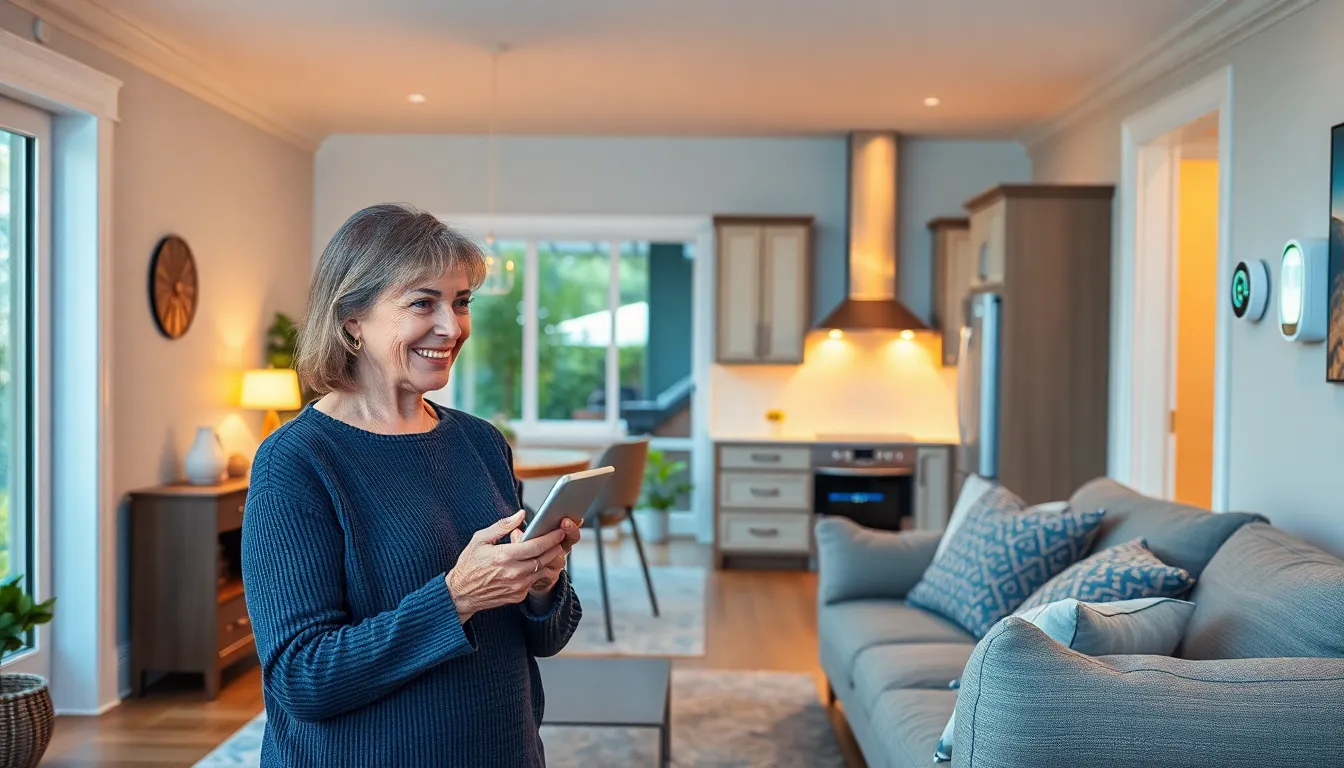Imagine controlling your home from anywhere—whether you’re lounging on a beach or stuck in a never-ending meeting. Remote home operation makes this dream a reality. With smart technology at their fingertips, homeowners can adjust lighting, temperature, and security systems without even getting off the couch. Who knew being a homebody could be this high-tech?
But it’s not just about convenience. Remote home operation can save time, energy, and even a few dollars on those pesky utility bills. Plus, it adds a layer of security that makes burglars think twice. So, why not embrace the future? Let’s dive into the world of remote home operation and discover how it can transform everyday living into something spectacularly effortless.
Table of Contents
ToggleOverview of Remote Home Operation
Remote home operation encompasses the use of smart technology to manage various home systems. Homeowners control lighting, heating, and security through their smartphones or tablets. This level of control provides convenience, allowing users to adjust settings while away. Intelligent devices like smart thermostats and security cameras enhance energy efficiency and safety.
Smart home systems offer automation features that simplify everyday tasks. For instance, lights can automatically turn on or off based on occupancy. Additionally, users can schedule appliances to run during off-peak hours, further reducing energy expenses. This functionality leads to noticeable savings on utility bills.
Security remains a primary concern for homeowners. Remote operation tools enable monitoring of security cameras and alarm systems from anywhere. Immediate alerts notify users of unusual activity, allowing for prompt action. Many systems also integrate with smart locks, providing keyless entry and tracking visitor access.
Integration is crucial in remote home operation. Many smart devices work together within a unified ecosystem. For example, a smart speaker can control lights, adjust the thermostat, and manage entertainment systems, all through voice commands. These integrated solutions enhance the user experience and streamline daily routines.
The benefits of remote home operation extend beyond convenience and savings. Improved accessibility features cater to individuals with mobility challenges. These adaptations allow for full home control with minimal physical effort. Thus, remote home operation supports various lifestyles and needs effectively.
Benefits of Remote Home Operation

Remote home operation offers numerous advantages that transform daily living. From convenience to enhanced security, smart technology greatly improves how individuals manage their households.
Convenience and Accessibility
Smart devices streamline home management. Homeowners can control appliances anytime through smartphones. Voice commands facilitate tasks, making life easier for those with mobility challenges. Scheduling features automate routine operations, such as adjusting thermostats or turning off lights remotely. This level of accessibility fosters independence, ensuring everyone enjoys full control over their living space.
Energy Efficiency
Reducing energy consumption stands as a primary benefit. Smart thermostats adjust temperatures based on occupancy, minimizing energy waste. Scheduling devices to operate during off-peak hours leads to substantial savings on utility bills. Monitoring energy usage in real-time helps identify inefficiencies, promoting more responsible consumption. Overall, this technology empowers households to reduce their carbon footprint while saving money.
Enhanced Security Features
Improving home security is another significant advantage. Remote monitoring tools allow homeowners to view live feeds from security cameras, ensuring peace of mind. Instant alerts notify users of unusual activity, such as break-ins or unexpected movements. Smart locks offer keyless entry, enhancing convenience while reinforcing security. Comprehensive systems can integrate alarms and sensors, ensuring safety at all times.
Technology Behind Remote Home Operation
Remote home operation relies heavily on innovative technology that empowers homeowners to manage their living spaces efficiently.
Smart Devices and Integration
Smart devices play a pivotal role in remote home operation. They facilitate control over lighting, heating, and security systems. Various devices connect seamlessly within an integrated ecosystem, enhancing user experience. For example, smart thermostats learn preferences and adjust settings automatically. By using smartphones or tablets, individuals can operate multiple devices from anywhere. Voice commands simplify interaction, allowing for hands-free management. Integration among these devices offers a streamlined approach to everyday tasks. Enhanced functionality supports routines tailored to specific needs, increasing convenience for all users.
Internet of Things (IoT) Applications
The Internet of Things (IoT) revolutionizes how homes operate remotely. Sensors and smart devices communicate continuously, creating a connected environment. Homeowners access real-time data regarding temperature and energy usage. Automated alerts notify users of unusual activity, reinforcing home security. Applications can schedule appliances to run during off-peak hours, promoting energy efficiency. Integration enhances not only daily convenience but also long-term savings. Remote monitoring through mobile apps empowers homeowners to make informed decisions. Increasingly, IoT applications are transforming residential spaces into smart, responsive environments.
Challenges of Remote Home Operation
Remote home operation offers convenience but comes with distinct challenges that users must navigate. Two significant concerns involve connectivity and reliability, alongside privacy and security.
Connectivity and Reliability Issues
Connectivity remains fundamental for smooth remote home operation. Smart devices depend on stable Wi-Fi signals. When disruptions occur, users might face issues controlling appliances or receiving alerts. Interference from walls or electronic devices can weaken signals, impacting performance. Users often need to consider their internet speed, as slow connections lead to delays in device responsiveness. Ensuring that devices are within range of the router or using mesh networks can alleviate some of these concerns. Overall, maintaining reliable connectivity is crucial for optimal functionality.
Privacy and Security Concerns
Privacy and security are paramount in the realm of remote home operation. Smart devices collect vast amounts of data, raising concerns about how this information is handled. Unauthorized access poses a risk, potentially allowing hackers to gain control of home systems. Homeowners must implement strong passwords and encryption to safeguard their networks. Regular updates for device firmware help patch vulnerabilities, thus enhancing security. Utilizing secure networks and understanding data privacy policies further protects user information. Addressing these concerns upfront strengthens the integrity of remote home systems.
Future Trends in Remote Home Operation
Emerging trends in remote home operation reveal significant advancements in technology and enhanced user experiences. These developments shape the future of smart home management.
Advancements in Technology
Artificial intelligence integration drives automation capabilities in smart homes. Devices equipped with AI learn habits and optimize settings based on user preferences. Smart sensors play a crucial role as they gather data on energy consumption, offering insights that lead to efficiency. Augmented reality features are gaining traction, allowing users to visualize home environments through mobile apps. Enhanced connectivity protocols, such as Wi-Fi 6 and Matter, ensure seamless device communication. Security advancements include facial recognition technology, which provides heightened safety measures.
User Experience Enhancements
Intuitive interfaces significantly improve user interactions with smart homes. Voice control features enhance accessibility for users with mobility challenges, making commands simpler. Customization options enable tailored experiences, allowing individuals to prioritize specific needs. Notifications provide real-time updates on crucial home activities, fostering awareness and peace of mind. Routine automation simplifies everyday tasks, such as adjusting temperatures or scheduling lights. Integration with wearable devices also contributes to a cohesive user experience, as monitoring health data can impact home settings. Overall, these enhancements prioritize convenience and personalization for all users.
Remote home operation is transforming the way people manage their living spaces. With smart technology at their fingertips homeowners can enjoy unparalleled convenience and security. The integration of various devices not only simplifies daily tasks but also promotes energy efficiency and cost savings.
As advancements continue to shape this landscape the potential for enhanced user experiences grows. From AI-driven automation to improved connectivity features the future of remote home operation looks promising. Embracing this technology can lead to a more comfortable and secure lifestyle tailored to individual needs. Homeowners are encouraged to explore these innovations and discover how they can elevate their everyday lives.




